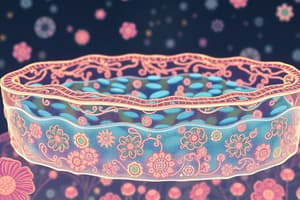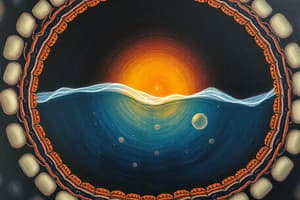Podcast
Questions and Answers
What effect does an increase in the degree of unsaturation have on the melting point of an acyl chain?
What effect does an increase in the degree of unsaturation have on the melting point of an acyl chain?
- Makes the melting point unpredictable
- Decreases the melting point (correct)
- Has no effect on the melting point
- Increases the melting point
What is one of the primary functions of lipids in biological systems?
What is one of the primary functions of lipids in biological systems?
- Contribute to protein structure
- Form lipid bilayer of cells (correct)
- Transport oxygen
- Synthesize carbohydrates
What is a primary function of lipoproteins?
What is a primary function of lipoproteins?
- Transport cholesterol and other fats (correct)
- Synthesize lipid hormones
- Store triacylglycerols exclusively
- Convert eicosanoids to arachidonate
Which type of lipids are primarily responsible for making up the cell membrane?
Which type of lipids are primarily responsible for making up the cell membrane?
Which lipoprotein is primarily responsible for transporting fats from the intestines to tissues?
Which lipoprotein is primarily responsible for transporting fats from the intestines to tissues?
What happens to the melting point of an acyl chain as its length decreases?
What happens to the melting point of an acyl chain as its length decreases?
Which of the following lipids serves as a signaling molecule?
Which of the following lipids serves as a signaling molecule?
Atherosclerosis is characterized by which of the following?
Atherosclerosis is characterized by which of the following?
What characteristic of the lipid bilayer allows its fluidity?
What characteristic of the lipid bilayer allows its fluidity?
What do high-density lipoproteins (HDL) primarily transport?
What do high-density lipoproteins (HDL) primarily transport?
What is the role of triacylglycerols in lipid metabolism?
What is the role of triacylglycerols in lipid metabolism?
What are eicosanoids derived from?
What are eicosanoids derived from?
Which of the following lipids is NOT a vitamin?
Which of the following lipids is NOT a vitamin?
Why is the lipid bilayer considered asymmetric?
Why is the lipid bilayer considered asymmetric?
What is the relationship between double bonds in acyl chains and their structure?
What is the relationship between double bonds in acyl chains and their structure?
Which lipid is derived from serine?
Which lipid is derived from serine?
What is the primary function of low-density lipoproteins (LDL)?
What is the primary function of low-density lipoproteins (LDL)?
Which lipoprotein is commonly referred to as 'good cholesterol'?
Which lipoprotein is commonly referred to as 'good cholesterol'?
What is the role of triacylglycerols in the body?
What is the role of triacylglycerols in the body?
Which of the following statements about high-density lipoproteins (HDL) is true?
Which of the following statements about high-density lipoproteins (HDL) is true?
What components make up lipoproteins?
What components make up lipoproteins?
What is the primary function of chylomicrons?
What is the primary function of chylomicrons?
Which fatty acids are generated during the breakdown of triacylglycerols?
Which fatty acids are generated during the breakdown of triacylglycerols?
What describes the lipid bilayer?
What describes the lipid bilayer?
What is the initial process required before fatty acids can be degraded?
What is the initial process required before fatty acids can be degraded?
What is the primary location of β-oxidation of fatty acids?
What is the primary location of β-oxidation of fatty acids?
Which molecule is primarily utilized to transfer acyl groups during β-oxidation?
Which molecule is primarily utilized to transfer acyl groups during β-oxidation?
How many ATP equivalents are used during the activation of fatty acids?
How many ATP equivalents are used during the activation of fatty acids?
What is produced as a result of the oxidation of odd-chain fatty acids?
What is produced as a result of the oxidation of odd-chain fatty acids?
What drives the reaction of fatty acid activation to acyl-CoA?
What drives the reaction of fatty acid activation to acyl-CoA?
Which of the following best describes the process of β-oxidation?
Which of the following best describes the process of β-oxidation?
In which phase is β-oxidation of fatty acids broken down into multiple units?
In which phase is β-oxidation of fatty acids broken down into multiple units?
What is the role of methylmalonyl mutase in fatty acid metabolism?
What is the role of methylmalonyl mutase in fatty acid metabolism?
What is produced during the oxidation of very long-chain fatty acids in peroxisomes?
What is produced during the oxidation of very long-chain fatty acids in peroxisomes?
Which type of fatty acids yields less energy upon oxidation compared to saturated fatty acids?
Which type of fatty acids yields less energy upon oxidation compared to saturated fatty acids?
What is the primary function of the carnitine transporter in fatty acid metabolism?
What is the primary function of the carnitine transporter in fatty acid metabolism?
In the context of fatty acid degradation, what is the purpose of TAG hydrolysis?
In the context of fatty acid degradation, what is the purpose of TAG hydrolysis?
During beta-oxidation, what happens to the total energy produced from odd-carbon fatty acids?
During beta-oxidation, what happens to the total energy produced from odd-carbon fatty acids?
Which of the following correctly describes an anaplerotic reaction in the context of the TCA cycle?
Which of the following correctly describes an anaplerotic reaction in the context of the TCA cycle?
What distinguishes the energy yield from unsaturated fatty acids during oxidation compared to saturated fatty acids?
What distinguishes the energy yield from unsaturated fatty acids during oxidation compared to saturated fatty acids?
What is the primary source of fatty acids used in fatty acid degradation?
What is the primary source of fatty acids used in fatty acid degradation?
Which molecule is formed as a result of the oxidation of odd-chain fatty acids?
Which molecule is formed as a result of the oxidation of odd-chain fatty acids?
What drives the reaction for activating fatty acids to acyl-CoA?
What drives the reaction for activating fatty acids to acyl-CoA?
Which of the following best describes the location where β-oxidation occurs?
Which of the following best describes the location where β-oxidation occurs?
During β-oxidation, fatty acyl-CoA is degraded into which of the following molecules?
During β-oxidation, fatty acyl-CoA is degraded into which of the following molecules?
What is the role of carnitine during β-oxidation?
What is the role of carnitine during β-oxidation?
How many ATP equivalents are necessary for the activation of fatty acids before they can be degraded?
How many ATP equivalents are necessary for the activation of fatty acids before they can be degraded?
Which enzyme catalyzes the formation of acyl-CoA from fatty acids?
Which enzyme catalyzes the formation of acyl-CoA from fatty acids?
What role does cobalamine play in fatty acid metabolism?
What role does cobalamine play in fatty acid metabolism?
Which of the following best describes the process of beta-oxidation in the context of energy production?
Which of the following best describes the process of beta-oxidation in the context of energy production?
What occurs during the oxidation of very long-chain fatty acids in peroxisomes?
What occurs during the oxidation of very long-chain fatty acids in peroxisomes?
In the context of fatty acid degradation, what is the purpose of TAG hydrolysis?
In the context of fatty acid degradation, what is the purpose of TAG hydrolysis?
What distinguishes the energy yield from unsaturated fatty acids compared to saturated fatty acids during oxidation?
What distinguishes the energy yield from unsaturated fatty acids compared to saturated fatty acids during oxidation?
Which statement is true about the carnitine transporter in fatty acid metabolism?
Which statement is true about the carnitine transporter in fatty acid metabolism?
What is the significance of methylmalonyl CoA in fatty acid metabolism?
What is the significance of methylmalonyl CoA in fatty acid metabolism?
What is a consequence of unsaturated fatty acid oxidation compared to saturated fatty acid oxidation?
What is a consequence of unsaturated fatty acid oxidation compared to saturated fatty acid oxidation?
Study Notes
Lipid Functions
- Lipids are crucial for cell structure, acting as the building blocks of the lipid bilayer.
- They serve as an energy source, with triacylglycerols being a primary storage form.
- Lipids act as signaling molecules, such as arachidonic acid.
- They are essential components of hormones, including estrogen, testosterone, thyroxine, and retinoate.
- Lipids are also involved in vitamin synthesis, particularly vitamins A, D, E, and K.
The Lipid Bilayer
- The lipid bilayer is a fluid structure, lacking a defined geometry.
- The head groups of the lipids have the ability to move up and down, while hydrocarbon tails are able to wave.
- The bilayer is asymmetric, meaning that different types of lipids are present in each "leaflet."
- The lipid bilayer is mainly composed of glycerophospholipids and sphingolipids.
Lipid Bilayer Components
- Glycerophospholipids are composed of glycerol, two fatty acid chains, and a phosphate group.
- They can have different head groups:
- Choline (phosphatidylcholine)
- Ethanolamine (phosphatidylethanolamine)
- Glycerol (phosphatidylglycerol)
- Serine (phosphatidylserine)
- They can have different head groups:
- Sphingolipids are composed of sphingosine, a fatty acid, and a head group.
- They include:
- Sphingomyelin (with a phosphatidylcholine head)
- Cerebrosides (with a monosaccharide head)
- Gangliosides (with an oligosaccharide head)
- They include:
Melting Point of Fatty Acid Chains
- The melting point of a fatty acid chain is influenced by its degree of unsaturation and length.
- More unsaturated fatty acids have a lower melting point because double bonds create kinks in the chain, decreasing packing efficiency.
- Shorter fatty acid chains also have lower melting points due to their reduced Van der Waals interactions.
Triacylglycerols
- Triacylglycerols (TAGs) are the main storage form of energy in the body.
- They are composed of glycerol with three fatty acid chains attached.
- When triacylglycerols are broken down, fatty acids are converted into two-carbon and three-carbon intermediates that can directly enter the citric acid cycle.
- Triacylglycerols are also referred to as fats or triglycerides.
Lipid Hormones
- Testosterone is an important male sex hormone, playing a crucial role in regulating male sexual development and reproductive function.
Arachidonate Conversion to Eicosanoid Signal Molecules
- Arachidonic acid is metabolized into various eicosanoid molecules, including prostaglandins, thromboxanes, and leukotrienes.
Lipoproteins
- Lipoproteins are essential for the transportation of cholesterol and other lipids throughout the body.
- They are composed of proteins and lipids, including cholesterol, phospholipids, and triacylglycerols.
Types of Lipoproteins
- Chylomicrons transport fats from the intestines to tissues and deliver cholesterol to the liver.
- Very-low-density lipoproteins (VLDL) transport triacylglycerols from the liver to other tissues.
- Low-density lipoproteins (LDL) are referred to as "bad cholesterol" due to their role in depositing cholesterol in the arteries, contributing to atherosclerosis.
- High-density lipoproteins (HDL) are called "good cholesterol" because they transport cholesterol from tissues back to the liver, reducing the risk of atherosclerosis
Atherosclerosis
- Atherosclerosis is a chronic disease that causes gradual hardening of the arteries, resulting from lipid accumulation in the blood vessel walls.
- It is a major contributor to heart disease.
Lipoprotein Function Summary
- Chylomicrons: Transport fats from the intestines to tissues and cholesterol to the liver.
- Very-low-density lipoproteins (VLDL): Transport triacylglycerols from the liver to tissues.
- Low-density lipoproteins (LDL): Transport cholesterol to the tissues. High levels can contribute to atherosclerosis.
- High-density lipoproteins (HDL): Transport cholesterol from tissues to the liver. High levels are associated with a lower risk of atherosclerosis.
Lipid Metabolism in Context
- Triacylglycerols, the body's main energy storage form, are composed of glycerol and fatty acids.
- Fatty acids are broken down into 2-carbon and 3-carbon intermediates that feed into the citric acid cycle, generating energy.
Summary of Key Facts
- Lipids are vital for multiple functions in living organisms, encompassing cell structure, energy storage, signaling, and hormone synthesis.
- The lipid bilayer, a key component of cell membranes, is a fluid and asymmetric structure, composed primarily of glycerophospholipids and sphingolipids.
- Triacylglycerols are a major energy reservoir, yielding fatty acid building blocks for metabolic processes.
- Lipid-derived hormones play crucial roles in regulating various bodily functions.
- Lipoproteins are specialized carriers, transporting cholesterol and fats throughout the body.
- Atherosclerosis, a chronic disease characterized by hardening of the arteries due to lipid accumulation, poses a serious threat to cardiovascular health.
Fatty Acid Degradation
- Fatty acids are primarily derived from triacylglycerols.
- Fatty acids are activated before degradation.
- Activation involves acylation to CoA, utilizing two ATP equivalents.
- The enzyme responsible for this activation is fatty acyl CoA synthetase.
- Beta oxidation occurs in the mitochondrial matrix utilizing carnitine as a transporter for acyl groups.
- Each round of beta oxidation consists of four reactions.
- These four reactions degrade acyl-CoA into acetyl-CoA.
Breakdown of Beta Oxidation
- The four steps of beta oxidation are:
- Dehydrogenation
- Hydration
- Dehydrogenation
- Thiolysis
- Beta oxidation produces NADH and FADH2.
- These coenzymes contribute to ATP production.
Odd-Chain Fatty Acid Oxidation
- Oxidation of odd-chain fatty acids yields propionyl-CoA.
- Propionyl-CoA is converted to succinyl-CoA through a series of steps requiring enzymes like methylmalonyl mutase and cobalamin.
- Succinyl-CoA enters the citric acid cycle (TCA cycle).
Unsaturated Fatty Acid Oxidation
- Unsaturated fatty acids produce less energy than saturated fatty acids due to bypassing steps in the beta oxidation process.
- This bypass results in a loss of NADH and FADH2, leading to reduced ATP production.
Peroxisomal Fatty Acid Oxidation
- Some fatty acid oxidation occurs in peroxisomes.
- Peroxisomes primarily deal with very long chain fatty acids.
- They shorten chains by transferring electrons directly to molecular oxygen instead of ubiquinone, producing hydrogen peroxide (H2O2).
- Catalase breaks down H2O2.
- Peroxisomes also handle branched fatty acids.
Summary of Fatty Acid Degradation
- Triacylglycerol hydrolysis is the first step.
- Activation of fatty acids with CoA is crucial.
- Carnitine facilitates the transport of fatty acids into the mitochondria.
- Beta oxidation consists of a set of four reactions that degrade acyl-CoA to acetyl-CoA.
- Acetyl-CoA then enters the citric acid cycle for energy production.
- Odd-chain fatty acid oxidation requires additional steps to convert propionyl-CoA to succinyl-CoA.
- Unsaturated fatty acids yield less energy due to bypasses in the beta oxidation pathway.
- Peroxisomes handle very long chain and branched fatty acids, shortening their chains and producing H2O2, which is then broken down by catalase.
Fatty Acid Degradation
- Triacylglycerols are the primary source of fatty acids.
- Fatty acids are activated before they are degraded.
- Activated fatty acids are acylated to CoA.
- Reaction is driven by ATP hydrolysis; 2 ATP equivalents are used.
- Fatty acylCoA synthetase is the enzyme responsible for the reaction.
- β Oxidation occurs in the mitochondrial matrix
- Acyl groups are transferred via carnitine.
- Each round of β oxidation has four reactions.
- Acyl-CoA is degraded into acetyl-CoA.
β Oxidation Reactions
- Step 1: Oxidation by FAD - Dehydrogenase removes two hydrogen atoms from the α and β carbons of the fatty acyl-CoA. The product has a double bond between the α and β carbons and FAD is reduced to FADH2.
- Step 2: Hydration - In the hydration step, water is added across the double bond. The product has an alcohol group at the β carbon.
- Step 3: Oxidation by NAD+ - Alcohol group is oxidized to a ketone by the removal of two hydrogen atoms. NAD+ is reduced to NADH.
- Step 4: Thiolysis - Coenzyme A attacks the β carbon. The bond between α and β carbon breaks. The product is acetyl-CoA and a fatty acyl-CoA that is two carbons shorter.
Odd-chain Fatty Acids
- Oxidation of odd-chain fatty acids yields propionyl-CoA.
- Propionyl-CoA is converted to succinyl-CoA through a series of reactions.
- Succinyl-CoA can enter the TCA cycle for further metabolism.
Unsaturated Fatty Acids
- Unsaturated fatty acids yield less energy than saturated fatty acids.
- The double bond in unsaturated fatty acids requires additional steps for oxidation.
- Electrons are passed from FADH2 to ubiquinone (Q) in the electron transport chain, but not in the oxidation of unsaturated fatty acids.
Peroxisome Fatty Acid Oxidation
- Very long chain fatty acids are oxidized in peroxisomes.
- The enzymes involved are called acyl-CoA oxidases.
- Electrons from the first step are transferred directly to molecular oxygen, which generates hydrogen peroxide (H2O2).
- Catalase breaks down H2O2.
- Branched-chain fatty acids are also oxidized in peroxisomes.
Summary
- Triacylglycerol hydrolysis produces fatty acids.
- Fatty acid activation involves using ATP to create fatty acyl-CoA.
- Carnitine transporter moves fatty acyl-CoA into the mitochondrial matrix.
- Beta oxidation breaks down fatty acyl-CoA into acetyl-CoA.
- Odd-chain fatty acids yield propionyl-CoA, which is metabolized to succinyl-CoA.
- Unsaturated fatty acids require additional enzymatic steps for oxidation.
- Peroxisomes degrade very long chains and branched-chain fatty acids.
Studying That Suits You
Use AI to generate personalized quizzes and flashcards to suit your learning preferences.
Description
This quiz explores the roles of lipids in cellular structure, energy storage, signaling, and hormone production. Additionally, it examines the composition and characteristics of the lipid bilayer, detailing the types of lipids involved. Test your knowledge on these essential biological components and their functions.




